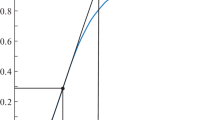Abstract
For single-in, single-out systems, SISO, the PID controllers have been by far the most frequently used controllers for a long time. The control of time-delayed systems is particularly challenging. There are some heuristic methods that can be used in the time and frequency domain. These are, for example, those by Ziegler Nichols or Chien Hrones and Reswick. The parameters that were found with it result in asymptotically stable regulated systems. In most cases, however, they show transient behavior that still requires readjustment. This publication presents a table for PID parameters that can be used to control systems with time-delayed, stable step responses. This minimizes the common quality criteria in the time domain, IAE, ITAE and ISE. The determination of the parameter sets is very computationally intensive. Therefore, an approach from the field of artificial intelligence was chosen for their calculation. The application of the parameter sets found is verified using an example of the control of a liquid level. The parameter sets also take into account the controller output limitations that are relevant in practice. They can basically be used for all PID controllers of controlled systems with a time delay.
Access this chapter
Tax calculation will be finalised at checkout
Purchases are for personal use only
Similar content being viewed by others
References
Ziegler, J.B., Nichols N. B., Optimum settings for automatic controllers. ASME Trans. 64, 759–768 (1942)
Chien, K.L., Hrones, J.A., Reswick, J.B.: On the automatic control of generalized passive systems. In: Transactions of the American Society of Mechanical Engineers, vol. 74, S. 175–185, Cambridge (Mass.), USA, Feb 1952
Qi, Z., Shi, Q., Zhang, H.: Tuning of digital PID controllers using particle swarm optimization algorithm for a CAN-based DC motor subject to stochastic delays. IEEE Trans. Industr. Electron. 67(7), 5637–5646 (2019)
Russel, S., Norvig, P.: Artificial Intelligence: A Modern Approach, 2nd edn, pp. 111–114. Prentice Hall, Upper Saddle River, New Jersey, ISBN 0–13–790395–2 (2003)
Büchi, R.: Machine learning for optimal ITAE controller parameters for thermal PTn actuators. In: Arai, K. (ed.) IntelliSys 2021. LNNS, vol. 295, pp. 137–145. Springer, Cham (2022). https://doi.org/10.1007/978-3-030-82196-8_11
Joseph, E.A., Olaiya, O.O.: Cohen-Coon PID tuning method, a better option to Ziegler Nichols-PID tuning method. Comput. Eng. Intell. Syst. 9(5) (2018). ISSN 2222-1719
Stephan, O., Docekal, T.: PID controller design based on global optimization technique with additional constraints. J. Electr. Eng. 67(3), 160–168 (2016)
Hussain, K.M., et al.: Comparison of PID controller tuning methods with genetic algorithm for FOPTD system. Int. J. Eng. Res. Appl. 4(2), 308–314 (2014). ISSN: 2248-9622
Büchi, R.: Modellierung und Regelung von Impact Drives für Positionierungen im Nanometerbereich (Doctoral dissertation, ETH Zurich) (1996)
da Silva, L.R., Flesch, R.C., Normey-Rico, J.E.: Controlling industrial dead-time systems: when to use a PID or an advanced controller. ISA Trans. 1(99), 339–350 (2020)
Silva, G.J., Bhattacharyya, A.D.S.P.: PID Controllers for Time-Delay Systems. Boston. ISBN 0-8176-4266-8.2005
Unbehauen, H.: Regelungstechnik. Vieweg, Braunschweig (1992)
Zacher, S., Reuter, M.: Regelungstechnik für Ingenieure. 15.Auflage, Springer Vieweg Verlag (2017)
Schwarze, G.: Bestimmung der regelungstechnischen Kennwerte von P-Gliedern aus der Übergangsfunktion ohne Wendetangentenkonstruktion, In: – messen-steuern-regeln Heft 5, S. 447–449 (1962)
Martins, F.G.: Tuning PID controllers using the ITAE criterion. Int. J. Eng. Ed. 21(5), 867–873 (2005)
Author information
Authors and Affiliations
Corresponding author
Editor information
Editors and Affiliations
Rights and permissions
Copyright information
© 2023 The Author(s), under exclusive license to Springer Nature Switzerland AG
About this paper
Cite this paper
Büchi, R. (2023). PID Parameter Tables for Time-Delayed Systems, Found with Learning Algorithms According to Minimum IAE, ITAE and ISE Criteria. In: Arai, K. (eds) Intelligent Systems and Applications. IntelliSys 2022. Lecture Notes in Networks and Systems, vol 544. Springer, Cham. https://doi.org/10.1007/978-3-031-16075-2_14
Download citation
DOI: https://doi.org/10.1007/978-3-031-16075-2_14
Published:
Publisher Name: Springer, Cham
Print ISBN: 978-3-031-16074-5
Online ISBN: 978-3-031-16075-2
eBook Packages: Intelligent Technologies and RoboticsIntelligent Technologies and Robotics (R0)




